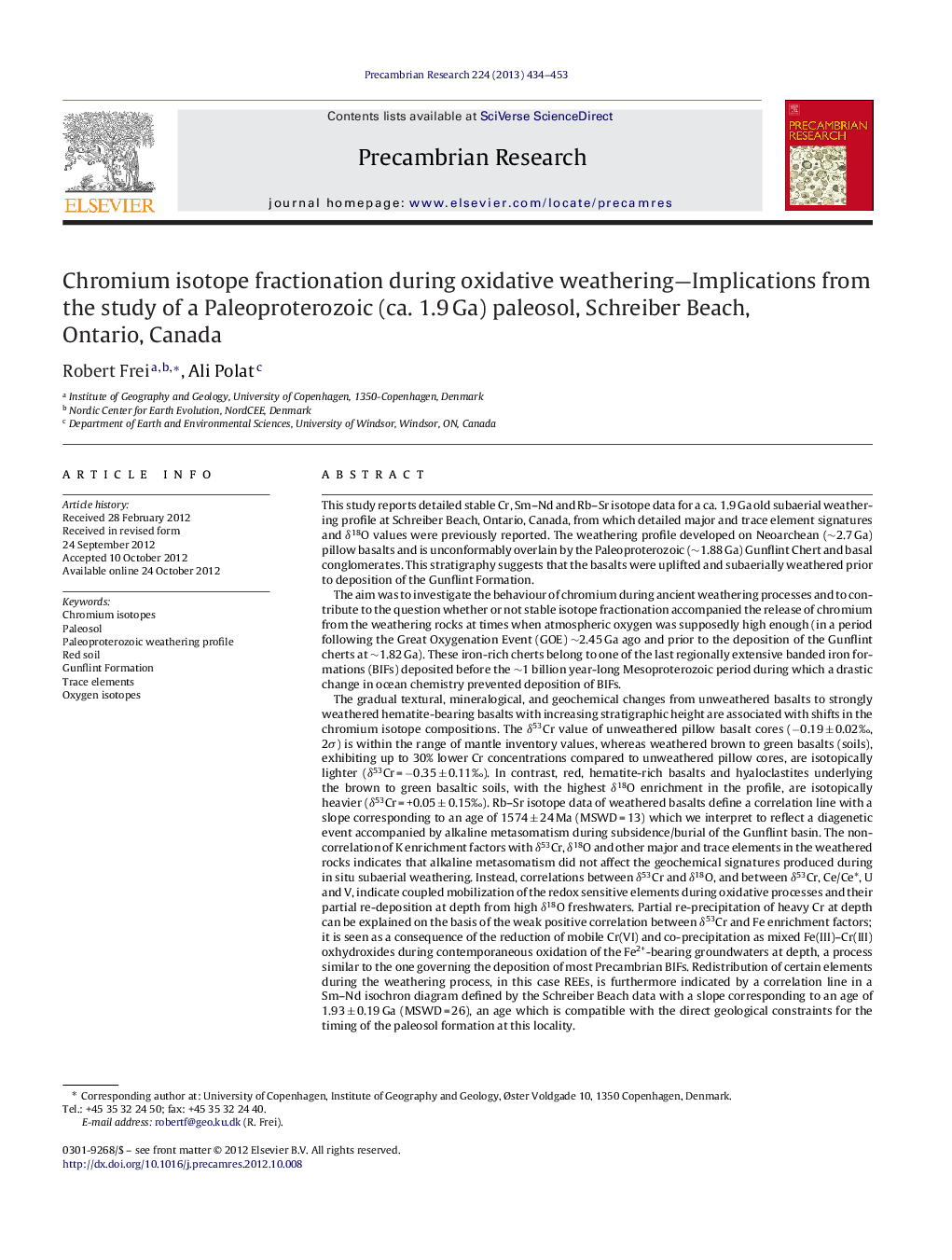| کد مقاله | کد نشریه | سال انتشار | مقاله انگلیسی | نسخه تمام متن |
|---|---|---|---|---|
| 4723356 | 1639650 | 2013 | 20 صفحه PDF | دانلود رایگان |

This study reports detailed stable Cr, Sm–Nd and Rb–Sr isotope data for a ca. 1.9 Ga old subaerial weathering profile at Schreiber Beach, Ontario, Canada, from which detailed major and trace element signatures and δ18O values were previously reported. The weathering profile developed on Neoarchean (∼2.7 Ga) pillow basalts and is unconformably overlain by the Paleoproterozoic (∼1.88 Ga) Gunflint Chert and basal conglomerates. This stratigraphy suggests that the basalts were uplifted and subaerially weathered prior to deposition of the Gunflint Formation.The aim was to investigate the behaviour of chromium during ancient weathering processes and to contribute to the question whether or not stable isotope fractionation accompanied the release of chromium from the weathering rocks at times when atmospheric oxygen was supposedly high enough (in a period following the Great Oxygenation Event (GOE) ∼2.45 Ga ago and prior to the deposition of the Gunflint cherts at ∼1.82 Ga). These iron-rich cherts belong to one of the last regionally extensive banded iron formations (BIFs) deposited before the ∼1 billion year-long Mesoproterozoic period during which a drastic change in ocean chemistry prevented deposition of BIFs.The gradual textural, mineralogical, and geochemical changes from unweathered basalts to strongly weathered hematite-bearing basalts with increasing stratigraphic height are associated with shifts in the chromium isotope compositions. The δ53Cr value of unweathered pillow basalt cores (−0.19 ± 0.02‰, 2σ) is within the range of mantle inventory values, whereas weathered brown to green basalts (soils), exhibiting up to 30% lower Cr concentrations compared to unweathered pillow cores, are isotopically lighter (δ53Cr = −0.35 ± 0.11‰). In contrast, red, hematite-rich basalts and hyaloclastites underlying the brown to green basaltic soils, with the highest δ18O enrichment in the profile, are isotopically heavier (δ53Cr = +0.05 ± 0.15‰). Rb–Sr isotope data of weathered basalts define a correlation line with a slope corresponding to an age of 1574 ± 24 Ma (MSWD = 13) which we interpret to reflect a diagenetic event accompanied by alkaline metasomatism during subsidence/burial of the Gunflint basin. The non-correlation of K enrichment factors with δ53Cr, δ18O and other major and trace elements in the weathered rocks indicates that alkaline metasomatism did not affect the geochemical signatures produced during in situ subaerial weathering. Instead, correlations between δ53Cr and δ18O, and between δ53Cr, Ce/Ce*, U and V, indicate coupled mobilization of the redox sensitive elements during oxidative processes and their partial re-deposition at depth from high δ18O freshwaters. Partial re-precipitation of heavy Cr at depth can be explained on the basis of the weak positive correlation between δ53Cr and Fe enrichment factors; it is seen as a consequence of the reduction of mobile Cr(VI) and co-precipitation as mixed Fe(III)–Cr(III) oxhydroxides during contemporaneous oxidation of the Fe2+-bearing groundwaters at depth, a process similar to the one governing the deposition of most Precambrian BIFs. Redistribution of certain elements during the weathering process, in this case REEs, is furthermore indicated by a correlation line in a Sm–Nd isochron diagram defined by the Schreiber Beach data with a slope corresponding to an age of 1.93 ± 0.19 Ga (MSWD = 26), an age which is compatible with the direct geological constraints for the timing of the paleosol formation at this locality.An oxidative atmosphere at ∼1.9 Ga, as implied by the results from the Schreiber profile, is furthermore supported by positively fractioned Cr isotopes (δ53Cr from +0.06 to +0.39‰) recorded in the iron-rich Gunflint Cherts directly above the palaeo-weathered horizons at Schreiber Beach. These values are interpreted to stem from a positively fractionated shallow seawater chromium composition at ∼1.88 Ga, potentially reflecting a continental run-off characterized by positive δ53Cr, and are in accordance with Cr isotope signatures in worldwide BIFs (including the Gunflint Iron Formation).Our results show the potential of Cr isotope studies on ancient paleosols to untangle the presence of oxidative weathering processes, making this isotope system a viable and important tracer for the reconstruction of surface oxygenation in Earth's history.
► We present negatively fractionated chromium isotopes in a 1.9 Ga paleosol.
► We contribute to the understanding of chromium release from the continents.
► Our study supports the use of chromium isotopes for tracing paleo-redox processes.
► Re-deposition of mobilized chromium happens at deeper levels in the paleosol.
► Rb–Sr and Sm–Nd geochronology date paleoweathering and subsequent K-metasomatism.
Journal: Precambrian Research - Volume 224, January 2013, Pages 434–453